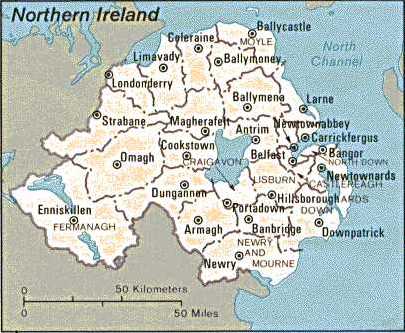Cascon Case ULS: Ulster 1968-

Status Quo Side: Protestant majority and UK government
Non-Status Quo Side: Catholic minority and Irish Republican Army (IRA)
Region: Europe
Conflict Type: External Intervention
Issues in Dispute: Ethnic, Governance, Territory
Maps: UTexas Maps
[Ireland
(small)]
[Ireland
(shaded relief)]
[United
Kingdom (small)]
[United
Kingdom 1988]
Phase 1: 1800s
In 1169 Pope Adrian IV granted of overlordship of Ireland to Henry II of England. After conquest by Norman barons, Ireland was ruled as a military colony exploited for profit of crown and aristocracy. The Protestant Reformation took root in Britain after Henry VIII's break with Rome. Ireland followed the Catholic Counter-Reformation. The 1607 "flight of the earls" left Ulster devastated by war. James I granted the land to loyal barons who encouraged influx of Protestant settlers from nearby Scotland. In 1690 a French-Irish army aiming to restore James II was defeated by William I aided by Ulster supporters. Ulster became largely Protestant; the south remained a mostly Catholic peasantry ruled by Protestant lords. The 1800 Act of Union transferred governance to London. Ulster developed industrially; the south remained agricultural. The 1846-50 Potato Famine resulted in massive starvation and emigration. Revolutionary activities led to the 1916 Easter Rebellion and creation of the Republic of Ireland (Eire). At independence in 1921 Britain retained six Ulster counties.
Phase 2: 1922
The Irish Free State, under British threat of war, accepted Dominion status but not partition, and civil war erupted. Anti-treaty forces (IRA) lost and became a clandestine terrorist unit. During the 1937 British abdication crisis, Ireland foreswore the crown but retained its British Commonwealth link until 1949. Britain insisted that Ulster's inclusion required consent of the Ulster Parliament, dominated by the (Protestant) Unionist Party and supported by Presbyterians (35% of the population) and the Church of Ireland (25%) with Catholics (35%) in opposition. Sporadic violence continued but relative stability was maintained until 1968.
Phase 3: 1968
Heightened Catholic resentment of economic and political discrimination, marked by protests, led to widespread violence, initially by the (Protestant) UDA (Ulster Defense Association) and later the Provo IRA. In 1969 responding to Provo raids on British army posts on the Ulster border, Britain sent troops. In 1972 the Ulster Parliament was suspended and in 1973 Britain assumed direct rule. Extremist factional terrorism increased. Violence abated somewhat after British-Irish negotiations in 1975, but intensified in 1980 in the north and in Britain and continued despite efforts at power sharing. 1991 talks between the British and Irish governments foundered on mutual suspicions. Secret talks between Northern (Catholic) MP John Hume and Sinn Fein President Gerry Adams provided the basis for the British and Irish Prime Ministers to agree in December 1993 on principles to govern the reconciliation process.
Phase 4: 8/31/1994
The IRA announced an unconditional cease-fire and intention to seek political solutions. Protestant paramilitary groups joined the cease-fire on October 13. Sinn Fein held out for direct negotiations without preconditions. An international commission headed by former US Senator Mitchell proposed a compromise formula. Britain ignored it and proposed special elections to test the strength of the parties' popular mandates.
Phase 3-2: 2/9/1996
After a 17-month hiatus the IRA resumed hostilities with several deadly explosions in civilian targets in London and subsequently in Ulster. The British and Irish governments agreed on special elections and all-party negotiations without preconditions. In the background, Ireland was prospering while Ulster stagnated, Catholics were moving up the socio-economic ladder, while ordinary people were sick of the bloody no-win conflict.
Phase 4-2: 1997
Late 1997 talks chaired by Mitchell and including Sinn Fein leader Adams and Ulster Unionist Party leader Trimble made progress, goaded by new British PM Blair and Irish PM Ahern. The April 10 "Good Friday settlement" gave Unionists an Ulster Assembly and ties to Britain so long as desired by a majority of Ulster voters. The nationalists got a cross-border link to Ireland through a North-South Council and a 70% voting requirement in the Assembly. On May 22 the power-sharing plan was confirmed in separate referenda.
On December 2, 1999, home-rule powers were transferred from London to Belfast, Ireland removed from its constitution the aim of incorporating Northern Ireland, and began the power-sharing arrangement. The IRA continued to refuse to start the process of disarmament ("decommissioning"), even symbolically, claiming that it meant "surrender," putting the peace-supportive Protestant coalition under new strain. On February 10, 2000, Britain suspended the power-transfer. After the May 7 the IRA commitment to "a process that will completely and verifiably put arms beyond use," the devolution process was restored.
Reference resources:
[UK Northern Ireland Office]
[Northern Ireland Executive]
[Ireland Maps]
[Ireland Maps]